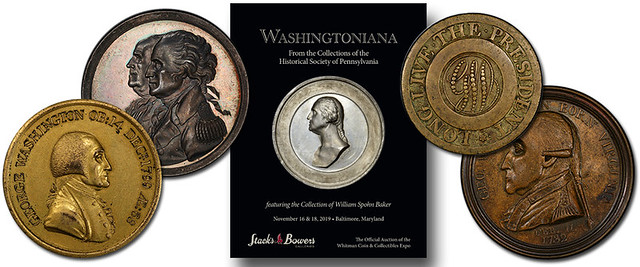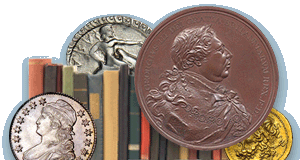
PREV ARTICLE
NEXT ARTICLE
FULL ISSUE
PREV FULL ISSUE
THE COLLECTION OF WILLIAM SPOHN BAKERNumismatic bibliophiles know about William Spohn Baker's classic book on the medals relating to George Washington. His reference collection, long owned by the Historical Society of Pennsylvania, is being auctioned this month by Stack's Bowers Galleries. Here's an excerpt from a blog article by cataloguer John Pack. -Editor  Perhaps the best starting point for a sale like this is a quote from William Spohn Baker, written in November 1884, as it summarizes the inspirations behind this landmark collection in the collector's own words: "Washington Medals form no inconsiderable portion of that great monument which love and gratitude have so steadily builded [sic], in memory of the services and virtues of the foremost man in American history. "This form of expression has, however, lost much of its historic significance and fitness in the absence of a systematic arrangement, by which all its features could be intelligently viewed and comprehended. Partial lists of the medals have been made, but without any attempt at classification, which while useful within their limits, have at the same time rather bewildered than aided the student or collector." Baker's name is legendary in American numismatics. For more than a century, it has been associated with the series of Washington medals, as it is he who first systematically and exhaustively organized this body of material in the 19th century in his 1885 work, Medallic Portraits of Washington. "Baker" is virtually synonymous with Washingtoniana. There are very few names from that period still in use in similar context today, though Sylvester Crosby with his Early Coins of America, Edward Maris' Coins of New Jersey, and William T.R. Marvin's Medals of the Masonic Fraternity come to mind as notable exceptions. It is perhaps the only such case, however, where the original reference collection has remained intact. The opportunity to handle a collection like this is, in a word, extraordinary. As a firm, we have handled several collections of the 19th century, the cabinets of the Garrett family and Walter Childs coming immediately to mind. However, in the Baker Collection we have something very different from the norm. Where most collections of the period are somewhat general in scope, or focused on circulating coinage issues, his was a deeply specialized cabinet focused solely on medals collected by a passionate and pioneering student of the series. Baker's motivation seems to have been, first and foremost, personal fascination with the historical subject. However, he was also deeply interested in expanding general understanding of the subject and saw the medals as an avenue one could take to accomplish this. The earliest medals were inspired by people who were Washington's contemporaries, and perhaps even knew him directly. Slightly later issues were devised by those who wished to memorialize him or his deeds for the next generation. Later, as Baker observed, the use of Washington's portrait was seen as adding gravitas to any subject at hand. In his introduction, Baker wrote: "It needs but a glance at the titles of the different groups, to reveal how the name of Washington is associated in the minds of a people, with all their diversified interests, pursuits and enterprises….If benevolence is to be awakened, patriotism aroused, emulation excited, temperance inculcated, industry stimulated, or events to be celebrated, the mind of the designer seems to turn at once to the Pater Patriae, and the medal struck for the purpose or occasion, must of course, bear his head as the prominent object." Though it may not have been central to his intent, it is worth noting that Baker's categorizations and groupings illustrated the inspirations for the various issues and separated the more important historic issues specific to Washington and his memory from those created for purely commercial purposes. Baker assembled his collection with primarily his own scholarship as a background. A small selection of the early medals had been well-described by James Ross Snowden, published as Medallic Memorials of Washington in the Mint of the United States, in 1861. For this Snowden worked simply from the medals that formed the Washington Cabinet in 1859, the seed that would become the National Numismatic Collection at the Smithsonian Institution. William Sumner Appleton published a listing of his extensive collection in 1873, including 296 types he owned and a few additional ones he was aware of. Entries in the American Journal of Numismatics likewise helped with data on known issues. However, Baker collected without benefit of systematic, comprehensive and detailed references as we understand them today. Beyond the mentioned references, and auction catalogs that offered specimens for sale, information was scarce. There was nothing to place this extensive and ever-increasing body of medallic work honoring Washington into proper context. In this, Baker saw an opportunity to create a thematic roadmap for future collectors. His goals were to make more accessible the history of the subject, and to expand understanding of the objects he enjoyed studying and collecting. He missed very little, and his accomplishment was remarkable. It is illustrative to consider that when Baker was assembling his collections of medals and engraved portraits, collectors did not have the benefit of easily accessible and vast photographic archives that present-day collectors rely upon. Collectors had to rely upon the written word, their own imaginations, and experiences with like items. Even Baker's own references were without illustration. Collecting in that time was, by necessity, a thoroughly academic and thoughtful pursuit. Baker's scholarship on the topic was perhaps unparalleled in his day. In The Pennsylvania Magazine of History and Biography, Vol. 22, No. 1 (1898), published by the Historical Society of Pennsylvania, John W. Jordan contributed an article, "In Memoriam. William Spohn Baker." Therein, Jordan wrote about the recently deceased Baker, as his contemporary: He practised [sic] his profession for some years, and then turned his attention to literary pursuits and historical research, particularly in all matters relating to Washingtoniana, of which he was recognized the foremost authority in the United States. His collection of medals, coins, and tokens numbers upwards of eleven hundred pieces. In bequeathing all his treasures to the Historical Society, he knew that they would always be appreciated and receive the care and attention he had bestowed upon them, and that they would be made accessible to the historical student." While we as numismatists know him well for his work with the Washington medals, Baker was an ardent student and collector of all scholarly works relating to Washington. His library included around 500 print volumes on his subject, while his collection of engravings and prints of Washington is said to have numbered as many examples as his cabinet of medals. He published numerous works of his own. His reference work on portraits, Engraved Portraits of Washington, was published in 1880, five years in advance of the reference numismatists have used to classify their Washington medals for over a century. Baker was a lifelong resident of Philadelphia, where he was born in 1824 to parents who had deep roots in the history of the area. One of his maternal great-great grandfathers arrived in Germantown in 1688 and one of his paternal great-grandfathers moved to Philadelphia in 1740, the latter serving in the American Revolution, as did others in his family. Baker was elected a member of the Historical Society of Pennsylvania in 1873 and was devoted to the Society for the remainder of his life. He became a member of its governing Council in 1885, and a vice president of the organization in 1892. According to Jordan's memorial, he was also affiliated with numerous other respected organizations, often holding offices therein. Among these may be counted the Pennsylvania Society of the Sons of the Revolution, the American Philosophical Society, the American Historical Association, the American Numismatic and Archaeological Society of New York, the New Jersey Historical Society, the Society of the War of 1812, and the Colonial Society of Pennsylvania. He was a director of the School of Design for Women for a few years, and served in the same capacity in the Pennsylvania Academy of Fine Arts, where he later became a vice president. He also held directorships in the Athenaeum of Philadelphia and in the Commercial National Bank. To read the complete article, see:
 Wayne Homren, Editor The Numismatic Bibliomania Society is a non-profit organization promoting numismatic literature. See our web site at coinbooks.org. To submit items for publication in The E-Sylum, write to the Editor at this address: whomren@gmail.com To subscribe go to: https://my.binhost.com/lists/listinfo/esylum All Rights Reserved. NBS Home Page Contact the NBS webmaster 
|